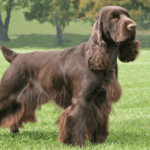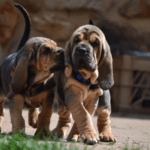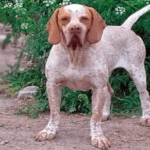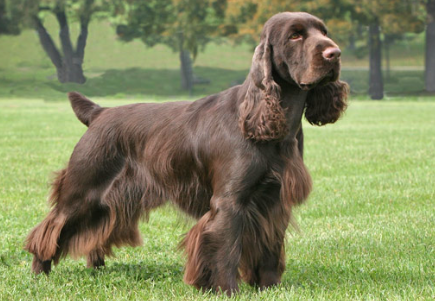The Mastador is a delightful blend of two distinct canine breeds, the English Mastiff and the Labrador Retriever. These charming pups inherit the finest qualities from their parents, resulting in a combination of size, energy, and affection. They excel in roles such as guarding, hunting, and providing companionship to families.
When raised by a caring family, Mastadors prove to be gentle giants. They possess a naturally calm demeanor but display immense friendliness towards their human companions. Each Mastador exhibits a unique personality, shaped by the traits inherited from their Bullmastiff and Labrador lineage.
If you seek a canine companion that responds quickly to familial bonds, the Mastador is an ideal choice. Consider adopting one of these magnificent creatures and experience the joy they bring to your household.
- Origin: North America
- Height: 26 – 32 inches
- Weight: 100 – 200 pounds
- Size: Medium-sized
- Lifespan: 8 to 14 years
- Colors: Black, yellow, tan, brindle, fawn, chocolate
Breed Characteristics
The Mastador is a hybrid dog resulting from the crossbreeding of a Labrador and a Bullmastiff.
Fascinatingly, despite the Bullmastiff’s English lineage, the Mastador’s development didn’t originate there. This mixed breed was first observed in America, though the precise date of its inception remains unknown. Nevertheless, records indicate that they’ve been bred for approximately three decades.
While this dog is a product of crossbreeding, a trend typically resulting in smaller breeds, the Mastador defies expectations, often weighing over 100 pounds, making it a notable exception to the norm.
| Energy: 4Point | Lifespan: 4Point |
| Trainability: 4Point | Sociability: 4Point |
| Health: 5Point |

History
The Mastador is a unique hybrid, combining the traits of the Labrador Retriever, a skilled waterfowl retriever, with the English Mastiff, known for its imposing size and unexpectedly gentle nature.
Mastiff-type dogs have a storied history, documented marching alongside Hannibal’s armies and depicted in ancient artwork from Mesopotamia and Asia. Renowned as steadfast guard dogs and loyal companions, they were highly valued by both commoners and nobility throughout England. However, the devastating impact of World Wars I and II nearly decimated breeds like the English Mastiff, due to their size making them vulnerable to food shortages and their utility as military dogs pulling munitions wagons.
Following the wars, the English Mastiff breed faced near extinction, with only a handful of individuals suitable for breeding. Importing Mastiff puppies from the United States and Canada helped revive the breed, eventually restoring its popularity, ranking 28th according to the AKC.
The Labrador Retriever also boasts a rich but somewhat mysterious history. Believed to have descended from the St. John’s dog, which disappeared as late as the 1980s, the Labrador’s origins are still debated. The St. John’s dog, adept at both swimming and retrieving, worked alongside fishermen in Newfoundland, specializing in retrieving fish, nets, and ropes.
In the 1800s, James Harris and Walter Scott, avid hunters, crossed their respective strains of St. John’s dogs, resulting in the modern Labrador Retriever we know today, renowned for its hunting prowess and amiable temperament.
Appearance
This crossbreeding yields dogs that typically range in size from 85 to 160 pounds, boasting long legs and athletic builds. They have broad heads, albeit narrower than those of purebred English Mastiffs. While the Mastiff’s notably short snout may occasionally be inherited, Mastadors more commonly display the square, medium-length muzzle characteristic of Labradors.
Mastadors may exhibit some wrinkling around the muzzle area, with almond-shaped eyes ranging from dark brown to hazel. Their triangular ears have rounded tips and hang close to the sides of their heads, enhancing their facial features.
Their double-layered coat comprises a water-resistant, thick outer layer overlaid by a shorter, somewhat coarse undercoat that lies close to the skin. Although the Labrador Retriever lineage may contribute to a slight variation in the coat texture, Mastadors typically inherit the dense fur characteristic of their Mastiff heritage.
Solid colors are predominant in Mastadors, with variations of black, brown, and golden hues, often accented by black or white markings on their chests and paws. Additionally, black face masks are commonly passed down from the Mastiff lineage.
Temperament
Mastadors, being mixed-breed dogs, do not have a standardized temperament or set of characteristics. The most reliable way to gauge what to expect from your Mastador puppy is to observe the traits of its purebred parents. However, it’s important to note that your puppy may not necessarily inherit all of these traits, so keep an open mind.
Labrador Retrievers are renowned for their friendly, laid-back demeanor and high intelligence. Often hailed as America’s favorite breed, Labs are relatively easy to train and possess natural athletic abilities, making them popular across various contexts. While they have abundant energy, especially in their younger years, Labs typically maintain a gentle and affectionate nature. They are eager to please and excel in obedience training and competitions when given the opportunity.
English Mastiffs may appear imposing, but they are affectionately known as the “gentle giants” of the large dog world. Despite their size, Mastiffs are incredibly intelligent and possess a vigilant nature that makes them excellent guardians. However, they are also remarkably gentle and loyal, making them well-suited for families with children. Early socialization is crucial for Mastiffs to ensure they remain comfortable around both people and animals, although they may remain cautious of strangers on their property.
Mastadors are generally considered to be a balanced blend of these two breeds. Expect your Mastador to exhibit a natural guarding instinct, although they may not match the athleticism of their Labrador relatives. Nevertheless, Mastadors can thrive in obedience training. Similar to Mastiffs, early socialization is essential to establish boundaries with new people and situations.
Importantly, Mastadors, like Mastiffs, do not tolerate being left alone for long periods. They prefer the company of their owners throughout the day, displaying a strong attachment. If you’re unable to commit to this level of companionship, it may be best to reconsider adopting a Mastador. They are likely to shadow you closely, so be prepared for a dog that craves close companionship.
Personality
The Mastador is renowned for its gentle and sweet-natured disposition, a trait that is well-founded. However, it’s important to handle this sensitive canine with care, as they can become shy, fearful, or even aggressive if mishandled. It’s imperative to avoid rough treatment of your Mastador and ensure that everyone, including children, treats them with kindness and respect.
In general, Mastadors tend to be polite but reserved around unfamiliar individuals, although they will readily defend their human family members if they perceive any threat. Typically, simply alerting their owners to potential danger is sufficient, but they may escalate their response if the threat persists.
Early training is essential to teach Mastadors to discern appropriate defensive behavior and to respond to commands to stand down when necessary. The temperament of a Mastador is influenced by various factors, including genetics, training, and socialization.
Health
Several factors contribute to the health and lifespan of a Mastador, beyond the hereditary traits inherited from their parent breeds. Similar to humans, diet quality and healthcare play significant roles. Generally speaking, with proper care in these areas, there’s no reason why a Mastador shouldn’t live up to 13 years.
Of course, unforeseen circumstances may arise, as they do in humans, which cannot always be predicted. However, as a general guideline, this lifespan expectation holds.
Two major factors influence lifespan: diet and timing of spaying or neutering. It’s crucial to provide your canine with a diet free from additives like gluten, wheat, and soy, which are known to cause health issues. While raw feeding is a popular option for its nutritional benefits, it can be expensive and time-consuming to prepare. Fortunately, raw food can be purchased online and delivered to your doorstep.
Equally important is the timing of spaying or neutering. It’s essential not to have your Mastador desexed before reaching full maturity, which typically occurs around 24 months of age. This is because sex hormones play a vital role in bone density and overall physical development. Spaying or neutering too early significantly increases the risk of conditions such as hip dysplasia, joint problems, and various cancers.
Dental Health
Regular dental care is essential for all canine breeds to maintain their overall health. Providing high-quality food alone is not sufficient; your dog also requires routine dental cleaning to ensure optimal oral hygiene. To keep your English Mastiff Mix healthy, it’s important to clean their teeth regularly using either dog toothpaste or a paste made from baking soda and water. Aim to perform dental cleaning a few times a week to prevent dental issues and promote a healthy life for your canine companion.

Care
Just like with any dog, it’s important to keep up with regular veterinary check-ups for your Mastador to detect any health issues early on. Your veterinarian can assist you in developing a comprehensive care routine tailored to keep your canine in optimal health.
Compared to Mastiffs, Labradors typically require more exercise. A Mastador mix generally benefits from around one hour of vigorous exercise each day. It’s essential to inspect their ears daily for debris and pests, cleaning them as recommended by your veterinarian.
Regular nail trims are necessary to prevent your dog’s nails from becoming too long, ideally performed once or twice a month to ensure they don’t click against the ground. Your groomer can assist with this task.
Consistently handle your Mastador’s paws, as dogs can be sensitive about their feet, and gently inspect inside their mouths. Make nail trimming a positive experience by offering praise and rewards, laying the groundwork for stress-free veterinary exams and other procedures as they mature.
Oral health is paramount for your Mastador’s care. Aim to brush their teeth at least two or three times a week to remove tartar buildup and bacteria. Daily brushing is even better for maintaining good dental health and preventing bad breath.
Occasionally, Mastadors may experience impacted anal glands, which occurs when they are unable to naturally clear the glands during defecation. If you notice your Mastador “scooting” or excessively licking their anal area, it’s best to take them to the veterinarian or a professional groomer to have the glands expressed. You can also learn how to perform this task yourself with proper instruction.
Best Food For
- Royal Canin Giant Puppy Dry Dog Food, 30 lb bag
- Wellness CORE Grain-Free High-Protein Large Breed Dry Dog Food, Natural Ingredients, Made in the USA with Real Chicken (Puppy and Adult Recipes)
- Bully Max High-Performance Super Premium Dog Food. for All
- Purina ONE SmartBlend Natural Puppy Dog Food
Feeding
A well-suited diet for a Mastador should be tailored to meet the needs of a large, energetic breed. They are prone to weight gain if overfed, so it’s crucial to adhere to a consistent feeding schedule and avoid leaving food out throughout the day. Additionally, it’s advisable to limit the amount of treats given to them.
Just like with any dog, the nutritional requirements of a Mastador will evolve from puppyhood through adulthood and into their senior years. It’s advisable to consult your veterinarian for personalized recommendations regarding your Mastador’s diet. Individual dogs vary significantly in factors such as weight, energy level, and overall health, making specific dietary advice essential.
Grooming
Due to their short and stiff coat that doesn’t require much maintenance, the Mastador is relatively low-maintenance when it comes to grooming. Daily brushing is recommended to manage shedding, though it’s typically minimal. However, during shedding season, which occurs twice a year, extra attention may be needed, and using a de-shedding tool can be beneficial, especially for households with allergy sufferers.
Bathing should be done as needed, typically once a month, to keep the dog clean. However, frequent bathing can lead to dry skin, so it’s essential to use grooming products suitable for dogs and consult with a veterinarian if unsure. Regular dental care is crucial for long-term dental health, including brushing teeth two to three times a week and inspecting and cleaning ears twice a week.
When it comes to grooming products, always use standard and veterinarian-approved ones. For cleaning ears, opt for a regular ear cleanser, and use regular dog toothpaste for brushing teeth. Trim your Mastador’s nails as needed to prevent them from becoming too long.
Training
Mastadors possess intelligence and are capable of learning various obedience commands. They respond well to positive reinforcement training methods, including the use of high-value treats and consistent praise delivered calmly. Harsher training techniques can backfire with these sensitive dogs, leading to stubbornness and resentment.
Patience and gentleness are paramount when training Mastadors, as they may feel overwhelmed by intense challenges. If you find yourself struggling with training, consider seeking assistance from a professional canine trainer who specializes in Mastiff-type breeds.
Participating in obedience classes and competitions not only provides valuable training and mental stimulation for your Mastador but also offers opportunities for socialization. Look for reputable canine classes that align with your dog’s needs and temperament to ensure a positive training experience.
Exercise
Regular exercise is crucial for keeping Mastadors healthy and preventing weight gain. While some Mastadors may eagerly participate in daily walks and exercise sessions, others may be more inclined to laze around. Regardless, they require several brisk walks each day to help manage their weight.
Joining a dog-friendly walking group can be a great way to ensure your Mastador gets enough exercise while also providing opportunities for socialization.
Due to their large size and natural inclination to roam, Mastadors need plenty of space to move around and explore. It’s essential to have adequate space for a dog weighing over 150 pounds, and a fenced-in yard is highly recommended to prevent them from wandering too far.
Adoption Center
Other Dog Breeds and Further Research
Mastador Puppy Dog Price
Check the documents and birth of their thoroughbred parents. A good or professed breeder will also allow you to see the puppies with their mama and father. They may also be suitable to give you a health examination and the puppy dog’s and parents ’ vital hipsterism score findings. generally, these puppies vend for between $ 900 and 2,000.











